Japan
Wood Products Prices
Dollar Exchange Rates of 15th
August
2025
Japan Yen 147.73
Reports From Japan
US tariffs are expected to dampen exports and
capital spending
Japan's economy is projected to grow a real 0.7% in the
current fiscal year revised down from an earlier estimate
of 1.2% as US tariffs are expected to dampen exports and
capital spending, according to the Cabinet Office.
In its midyear report the government revised down its
fiscal 2025 export growth projection to 1.2% from 3.6% in
January taking into account the impact of tariffs on key
auto and other industries.
Business investment is now projected to rise 1.8%,
downgraded from the previous estimate of 3% as
companies become cautious on expanding production
capacity amid weaker export prospects. Private
consumption, which accounts for more than half of Japan's
economy, is projected to rise 1% compared with an earlier
forecast of 1.3% as inflation erodes consumer sentiment.
See:
https://mainichi.jp/english/articles/20250807/p2g/00m/0bu/043000c
Economist - strengthen cooperation with Asian and
European countries
A former International Monetary Fund Chief Economist
has urged Japan to strengthen its cooperation with Asian
and European countries given disruptions to the global
economic and financial order caused by US policies.
In a recent interview with Jiji Press, the economist
expressed concern that US policy measures including high
tariffs and tax laws expand the federal debt and creates
uncertainty. He also said such actions are driving trade
partners to deepen integration with countries other than the
United States.
See: https://sp.m.jiji.com/english/show/41950
Africa conference explores partnerships with Japanese companies
The 9th Tokyo International Conference on African
Development (TICAD 9) will be held in Yokohama from
August 20 to 22, 2025. TICAD 9 will feature discussions
on a wide range of development themes in Africa.
Discussions on “Driving Japanese Investment in Africa
Through World Bank Group Guarantees” is expected to
draw considerable interest among Japanese companies
looking to diversify. This event will explore how this
initiative, along with strategic partnerships with Japanese
companies, can contribute to promoting private investment
in Africa.
Since last year the World Bank Group has launched and
been accelerating the development of a new platform that
consolidates all guarantee products and related experts
from across its institutions under the Multilateral
Investment Guarantee Agency (MIGA).
See:https://www.mofa.go.jp/files/100886477.pdf
and
https://www.mofa.go.jp/region/africa/ticad/ticad9/index.html
Weak yen eroding household purchasing power
A recent government report has said the weak yen is
hurting Japanese households' sentiment and eroding their
purchasing power a signal of the government’s concern
over the negative economic impact of the exchange rate.
A decade ago expectations that inflation was rising helped
improve household spending but today the prospect of
price inflation against the back drop of the weak yen,
which has pushed up prices for imports, has undermined
householder confidence.
See:
https://www.japantimes.co.jp/business/2024/08/02/economy/japanese-economy-weak-yen/
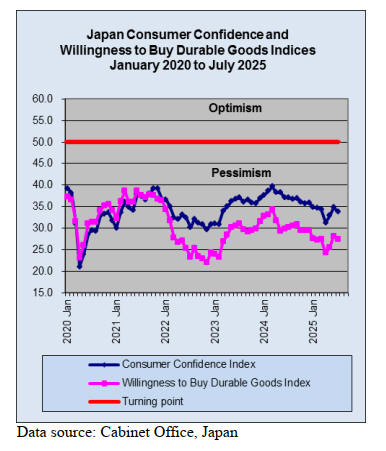
Panel proposes record minimum wage increase
Last year the government announced plans to raise the
average minimum wage to yen 1,500 per hour by the end
of the decade.
The Kyodo News Agency reported that to advance this
aim the Ministry of Labour’s Central Minimum Wages
Council recommend an increase of about 6% in the
national average minimum wage for this fiscal year, the
biggest increase since 2002. Raising the legally binding
minimum wage would boost households' purchasing
power but would be a major challenge for small
companies.
See:
https://www.japantimes.co.jp/news/2025/08/01/japan/minimum-wage-hike-plan/
Concerns on speculation in currency market
Japan's Finance Minister indicated the government is
concerned about trends in the currency market including
speculative movements. These comments came after the
yen briefly weakened to the 150 level against the US
dollar following a Bank of Japan decision to leave interest
rates unchanged.
Strategists have cautioned of the risk that the yen could
depreciate further raising the risk of authorities stepping
into the market to support the yen.
In other news, the Finance Minister said that recent trade
agreements with the EU and the US have helped reduce
uncertainty surrounding trade policy.
See:
https://www.japantimes.co.jp/business/2025/08/01/economy/kato-concern-yen-weak/

Land price up for fourth year
The National Tax Agency has reported the average price
of land in Japan rose 2.7% in the first half of 2025, the
fourth straight year it has risen and the fastest pace of
increase since the calculation method was changed in
2010. It has been suggested the booming tourist sector has
pushed up values.
See: https://asia.nikkei.com/business/markets/property/price-of-
land-in-japan-rises-2.7-as-tourism-drives-values
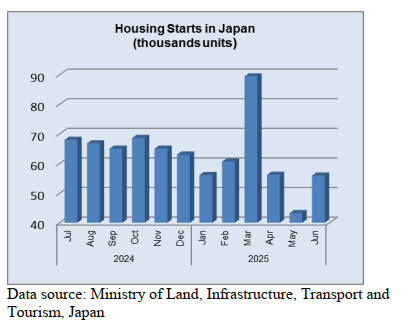
Extreme heat
Temperatures in Japan are rising and August tempertatures
reached 41 degrees Celsius in central Japan. Officials are
urging the public to take thorough measures against
heatstroke.
The Japan Meteorological Agency says recently the
mercury reached 41.4 degrees Celsius in Shizuoka
marking 7 days with a temperature over 40 degrees in
Japan tying the record set in 2018. Heatstroke alerts were
issued for areas from Tohoku in the northeast to Okinawa
in the southwest.
Import update
Assembled wooden flooring imports
The main category of assembled flooring imports in June
2025 was HS441875, accounting for 61% (58% in May)
of the total value of assembled flooring imports. Of
HS441875 imports, 91% was provided by shippers in
China, Viet Nam and in Malaysia. The other main sources
of assembled flooring (HS441875) in June were Indonesia
and Thailand.
The second largest category in terms of value in June 2025
was HS441873 18% (21% in May) all of which was
shipped from China. The third and fourth largest
categories in value terms were HS441879 (9%) and
HS441874 (5%).
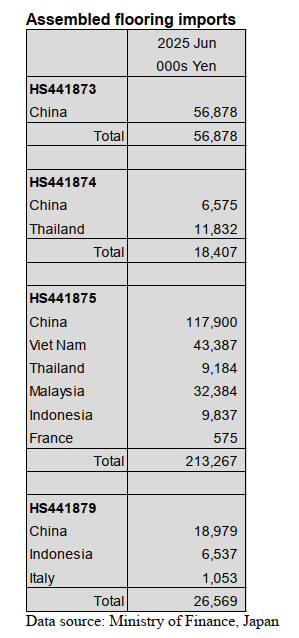
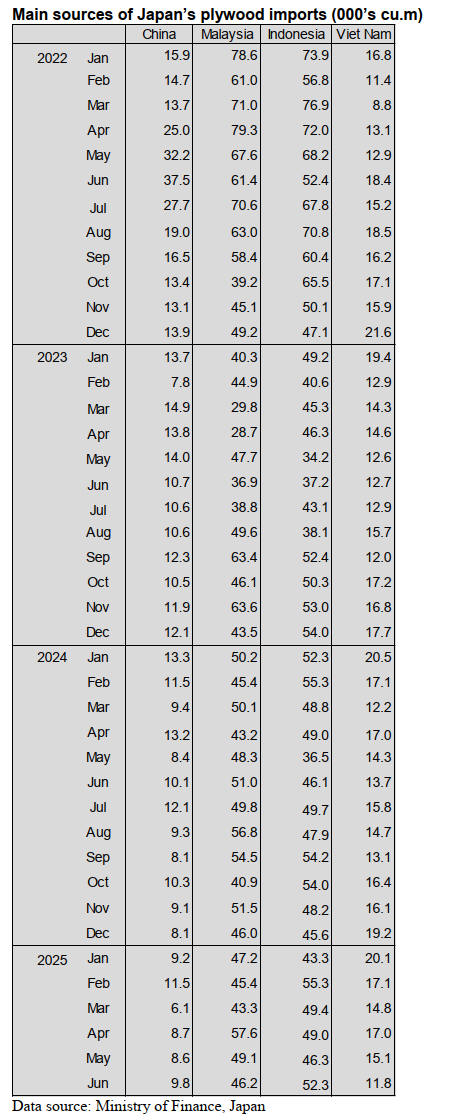
In June 2025 arrivals of HS441210-39 were reported at
121,000 cu.m and this was at the same level as reported in
May 2024 (120,000 cu.m ).
Plywood imports
Malaysia and Indonesia were the top suppliers of plywood
to Japan in June as in previous months. The volume of
June imports from Malaysia continued the downward
trend seen in May and the volume recorded from Vietnam
was also down compared to a month earlier. Only
Indonesa say a rise in June plywood arrivals.
The housing sector is a major consumer of plywood and
June housing starts in Japan were significantly higher than
in May but still below the average for the past 12 months
As in previous months, of the various categories of
plywood imported in May 2025 HS441231 was the largest
(86% of total imports) followed by HS441233 (6%) and
HS441234 (5%). The balance was of HS441239.In June
over 95% of the plywood shipped to Japan from Indonesia
and Malaysia was HS441231. Viet Nam was the main
supplier of HS441234 in June.
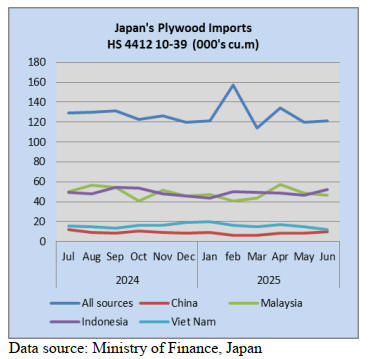
Trade news from the Japan Lumber Reports (JLR)
The Japan Lumber Reports (JLR), a subscription trade
journal published every two weeks in English, is
generously allowing the ITTO Tropical Timber Market
Report to reproduce news on the Japanese market
precisely as it appears in the JLR.
For the JLR report please see:
https://jfpj.jp/japan_lumber_reports/
Exporting logs to Thailand
Since 2024, the Yamagata Prefectural Federation of Forest
Cooperatives has been promoting export initiatives to
develop new sales channels for locally sourced timber and
to address restrictions on supply caused by the declining
demand for Japanese cedar.
The export of Japanese cedar logs to Thailand is gaining
attention nationwide as an exceptionally rare initiative.
This export initiative is based out of Sakata Port, with the
Yamagata Prefectural Federation of Forest Cooperatives
taking the lead in collecting the timber, and is being
carried out through the National Federation of Forest
Cooperatives.
For the 2024-bound exports to China, bulk carriers were
used, and by June 2025, five vessels had transported a
total of approximately 17,000 cbms of Japanese cedar
logs. The export to China played a significant role in
facilitating the successful trade negotiations for the export
to Thailand.
The Japanese cedar logs bound for Thailand— each
measuring 3.65 metres in length will be exported using
containers, with the initial shipment planned at
approximately 200 cubic metres.
Sharing fire-resistant timber construction technologies
Shelter Co., Ltd. has reached an agreement to provide its
timber construction and fire-resistant wood building
technologies to Haring, a major European laminated
timber company based in Switzerland with a history
spanning over 140 years.
By licensing Shelter's timber earthquake-resistant
construction method and fire-resistant wood components
to Haring, the initiative aims to promote the spread of safe
wooden buildings in Europe and expand the market. In
overseas timber construction, there is generally no concept
of fire-resistant architecture involving the covering of
wooden structural frames with fireproof materials such as
gypsum board.
In urban areas of Japan, it is essential to construct fire-
resistant wooden buildings that can withstand fires without
firefighting intervention, in anticipation of scenarios where
fire trucks cannot promptly reach the affected site during a
major earthquake, an event often accompanied by
numerous fires.
South Sea logs and lumber
Shipment movement for South Sea lumber also continues
to show strong signs of stagnation.
Even at the source regions, factors such as worsening
economic sentiment in countries other than Japan and
growing uncertainty caused by U.S. tariff measures have
contributed to the cautious market outlook.
However, given the high production costs across all
sourcing regions, it remains difficult for suppliers to
makem price reductions easily.
Overall shipment movement for South Sea wood and
Chinese product remains sluggish. While certain items,
such as decking materials, are seeing moderate interest,
weak demand continues to dominate the broader market.
However, due to low inventory levels in distribution
channels, domestic distributors tend to secure only the
physical stock needed to meet immediate job
requirements.
South Sea logs, including those imported from Papua New
Guinea between late April and early May, 2025 have been
well distributed.
Additionally, consistent shipments from Sabah and
Sarawak States in Malaysia have helped maintain a stable
supply-demand balance without noticeable shortages or
surpluses.
U.S. Tariff Measures
On July 7, 2025, U.S. President Donald Trump announced
new tariff rates for 14 trading partner countries, including
Japan and South Korea. The measure stipulates that a 25%
tariff will be imposed on imports from Japan starting
August 1, 2025. Currently, the United States imposes a flat
10% tariff on imports from Japan. However, the additional
14% reciprocal tariff had been temporarily suspended until
July 9, 2025.
Previously set at a total of 24%, the new tariff has been
slightly increased to 25%. It was also decided to extend
the suspension period for reciprocal tariffs, originally set
to expire on July 9, 2025 until August 1, 2025.
The recent announcement did not specifically mention
Japanese wood products imported into the United States.
However, relatively high-value processed items are
expected to be subject to an additional 25% on top of the
WTO tariff rate. Other wood-related products are expected
to remain exempt. An agreement was reached at 15 % as
of the 22nd.
On July 10, 2025, the U.S. President announced via his
social media account that a 35% tariff will be imposed on
Canadian imports starting August 1, 2025.
The specific items subject to the measure are unclear.
Currently, the Trump administration has imposed a
standard 25% tariff on Canadian imports, citing issues
such as the influx of illegal drugs.
However, products covered under the United States-
Mexico-Canada Agreement are exempt from this measure.
Survey of construction companies
The National Federation of Construction Worker’s Unions
conducted a survey on the impact of soaring prices for
housing materials and equipment and has released the
results. While the delivery delays that had been a problem
until around 2023 appear to have been largely resolved,
the rising costs of construction work continue.
The response to the legal revision in April 2025 has raised
concerns, particularly about increased financial burdens
for large-scale renovation projects. The survey was
conducted from April 9 to May 30, 2025 with responses
collected from 1,196 companies.
Q1. Regarding the delivery time for equipment and
building materials
92.0 %, 1.9 point up from last time - No delivery delays.
8.0 %, 1.9 point up from last time - Taking longer than
usual to be delivered
Q2. Regarding the impact of construction cost
26.1 %, 1.6 point down from last time - It has increased
significantly.
63.5 %, 5.7 points up from last time - It increased.
10.4 %, 4.0 points down from last time - Flat
Q3. Regarding the impact to the customers
34.0 %, 4.5 points down from last time – A significant
impact has been observed.
57.8 %, 4.2 points up from last time - There has been a
slight impact
8.2 %, 0.3 point up from last time – No impact
Q4. Covering the cost increase
68.9 %, 4.4 points up from last time – Customers
26.7 %, 2.3 points down from last time - Partially borne by
the company
4.4 %, 2.1 points down from last time - Fully borne by the
company
Q5. Utilissation of the housing energy efficiency
campaign subsidy programme
46.0 % - Utilized
54.0 % - Didn’t utilize
Q6. Concerns Regarding Compliance with the Revised
Building Standards Act and the Building Energy
Efficiency Act.
52.7 % - There are concerns
1.3 % - There is no concerns
36.0 % - It remains uncertain. There is ambiguity
regarding the outcome.
Q7. Utilisation of domestic wood.
4.6 % - All domestic wood
49.7 % - Use domestic timber as much as possible
4.8 % - Domestic wood is seldom used
40.9 % - The source of the materials is not considered
Q8. Utilisation of locally produced wood
9.2 % - Yes
60.8 % - No
|